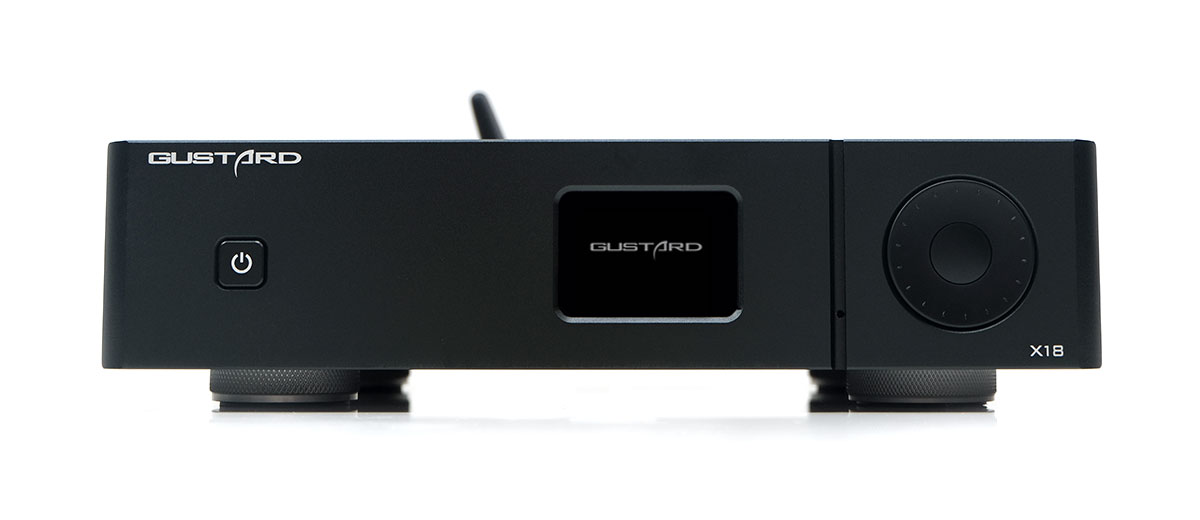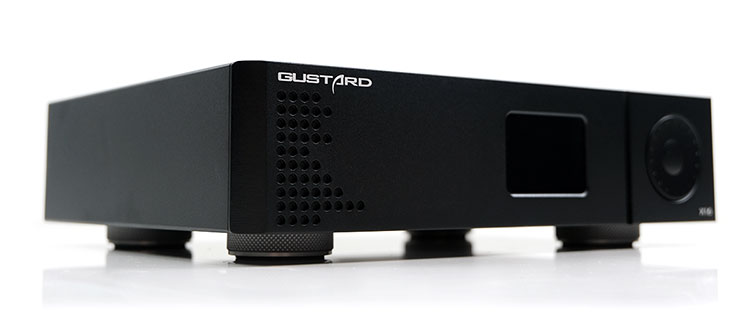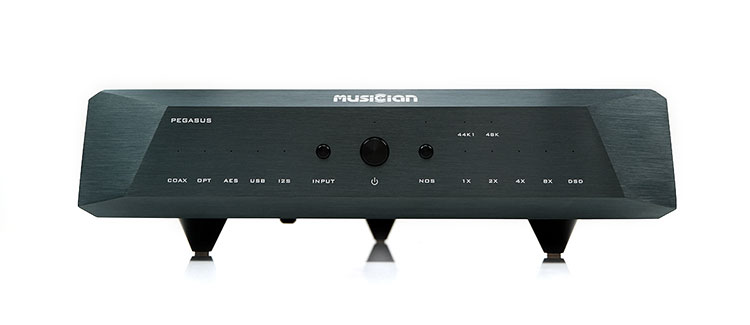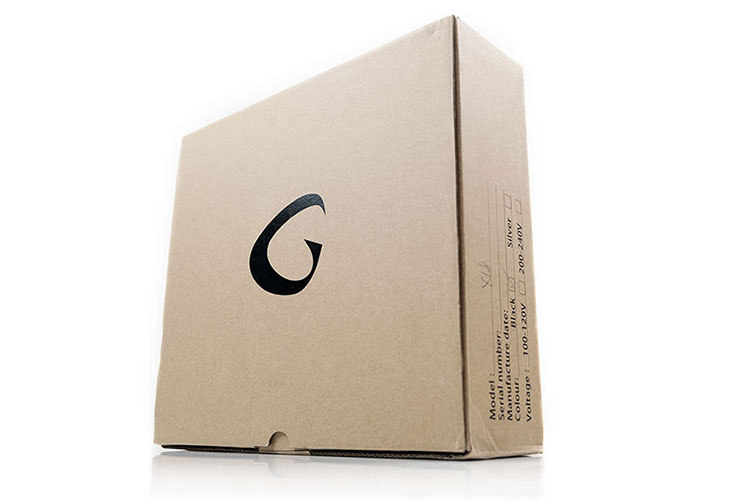Select Comparisons
For all comparison work, we split amp duties between the Auris HA-2SE and the Ferrum OOR/HYPSOS combo with the USB to PC as the primary source transport. The headphones were a mix of the T+A Solitaire P and the Audeze LCD-5.
Gustard X16
The X16 is the forerunner to the X18 with many shared features but comes in a bit cheaper and with a lower grade DAC implementation. You can read our review from last year here.
$499.99
Technical
Internally, these devices do have a lot of similarities. However, the biggest upgrade is the DAC and supporting I/V of the X18 DAC which uses a single 8-channel ES9038PRO compared to the X16’s dual ES9068AS.
That is an increase from a 4-channel in a dual configuration mode to an 8-channel in a single implementation with a larger count of 8 independent OPA1612A I/V conversion chips resulting in a 2B increase in dynamic range on paper.
Alongside that, the CPLD has changed from the older Altera MAX II to the newer MAX V with reduced power consumption and improved clock efficiency.
In other areas, things remain the same including both DACs using a dual Accusilicon Femtosecond Crystal Oscillator for jitter control, an XMOS USB input into the digital bridge, and a BT5.0 module for wireless transmission.
Decoding is also unchanged at up to DSD512, PCM 32BIT/768kHz, and up to MQA 8X for unfolding and upsampling. Both the X18 and the X16 have fully balanced signal designs and both can operate as a DAC and a pre-amp to an amplifier. Note, that the X18 DAC pre-amp voltage output has increased from X16’s 2V SE and 4V to 2.5V SE and 5V balanced.
Design
The dimensions are the same and the weight is the exact same. So also, the color choices of black and silver. In fact, aesthetically speaking the minimalist and clean design language of these two DACs identical save for the power button on the front of the X18 DAC and its lack of machine circles on the far left of the front panel.
That means two very compact and stackable desktop DACs but with the advantage of being able to quickly turn on the X18 with the power button to the front. Mind you, both still have a power switch to the rear so just how much of an advantage for the X18 is debatable. The rear panel, save for a few physical relocations, has the exact same I/O also.
There are two other nuanced differences. The OLED panel of the X18 DAC has a larger font and a more legible layout with a slightly off-blue or white tone making it easy to read compared to the minute font of the X16 screen. The other difference is the BT antennae which is larger on the X16 but of a slightly cheaper quality compared to the stubby version on the X18 DAC.
Performance
Right away you can tell the X16 struggles a bit more with the treble quality on the Solitaire P when compared to the more natural tone of the X18. It sounds a little edgier, thinner, and further forward which never quite suites the Solitaire P’s 5-7k peak.
The LCD-5 is better on the X16 but once you switch to the X18 both headphones sound smoother and more forgiving with this setup. Additionally, the X16 decay from upper midrange notes sounds a bit shorter. It sounds comparably abrupt and dry in its delivery, with a more digital quality to the timbre.
The X18 attack is generally better balanced with a slightly liquid break, nothing too edgy, and a longer level of decay that gives percussion notes a more life-like quality. Neither are overly warm DACs but the X18 does have a more agreeable harmonic balance through the mids and highs with the HA-2SE as the main amplifier.
On the low end, the X18 also seems a lot more dynamic in its delivery compared to the X16. Now one thing I noticed was the gain level on the pre-amp control which seems to be higher on the X18 compared to the X16. Comfortable listening levels were around -11dB using the Solitaire P and -10dB on the X18.
However, even at 1dB lower, the X18 bass sounded fuller and more impactful than the slightly thinner but still quite deep-sounding X16 performance.
With NOS mode turned on the X16 timbre has a bit more of a rounded quality, with slightly less treble overtone bleeding into the instrumental coloration. However, it still lacks the dynamics and gusto on the low end of the X18’s performance with its NOS turned off.
Chord Electronics Qutest
£1195
The Qutest was launched in 2018 with our full review towards the end of 2018. We also gave it our Top Gear Award for the Best DAC in 2018. You can read more on the Qutest here.
Technical
Two very different approaches here with the delta-sigma of the X18 DAC and the FPGA filter-based in-house DAC of the Chord Qutest.
Chord has gone to great lengths to pitch the tap count of their DACs as being superior to the delta-sigma equivalent with 1000’s of additional taps with their estimation of delta-sigma sitting around 200-300 taps compared to most 50k via its FPGA Xilinx Artix 7 chipset and a 10-element Pulse Array design.
That being said the X18 DAC does match the Qutest for top-level decoding rates at DSD512 and PCM 32BIT/768kHz. It also includes MQA 8X, something which Chord religiously swerves as they have a dim view of MQA as a suitable audio format.
The Qutest does not have any wireless capability either but it does offer a dual BNC input which gives it a modular expansion capability to fit alongside the amazing Hugo M Scaler. If you want 705k upsampling then that combo will do it all.
Both offer coaxial (single BNC for the Qutest) and optical input but on the analog side, the Qutest is single-ended only with 3 voltage outputs, 1V, 2V, and 3V. The X18 DAC can offer both SE and balanced outputs and its pre-amp output ratings are a little higher at 2.5V SE and 5V balanced. It also offers variable volume control whereas the Qutest is fixed.
Design
The X16 DAC is compact, the Qutest even more so to the point of rating it as one of the smallest high-end DACs in the market. Both have system-pitched designs with the Qutest now racked with the Anni analog amplifier and the Huei phono stage and the X18 possible with the U18 or even their 16 series amps and streamers since the size is identical.
Aside from the form factor, the key design difference between these two is the control system. The X18 DAC uses a classic multifunction dial, remote control, and OLED display whereas the Qutest uses the esoteric color orb system.
The orb system can be polarizing given its high learning curve requirement, (memorizing colors basically), and slight unintuitive navigation system. I will admit it is aesthetically pleasing and fairly low maintenance, however. It fits nicely with the entire Chord design philosophy throughout their product ecosystem but, personally, I prefer the simpler OLED display of the X18.
The I/O is more expansive on the X18 DAC though bear in mind the dual BNC of the Qutest can hook up to the M Scaler or double up as coaxial inputs. That being said balanced output fans will find the X18 more suitable with its XLR connectors.
Performance
With NOS turned off, the X18 DAC comes fairly close to the performance level of the Qutest. Tonally, there is not a huge amount of difference between these two with both going for a cleaner more reference-like tone.
It is really the technical differences once you spend some time with them that stand out. For me, the Qutest has a bit more energy and high-frequency extension and is not as linear or as flat as the X18 DAC treble. You get just a hint more sheen on the midrange and percussion timbre and a bit more of an edge on bass notes also.
Some of that edge on the low end is more emphasized as the Qutest just pushes out the sub-bass rumble a bit more aggressively. Again, the X18 DAC stays the marginally flatter of the two here but is still very punchy.
The X18 DAC does convey a tiny bit more warmth also throughout, perhaps due to the comparative treble attenuation taking some of that clean edging off the instrumental timbre notes. Midrange instrumentation on the Qutest has an airier grander feel to their staging presentation.
More air on the Qutest treble top end and a bit more sparkle strengthens the Qutest staging quality, sounding a bit taller and wider, at least in terms of being able to pick up the nuanced spatial cues floating above and around you.
As a result, the X18 DAC will come across as a little more upper bass to mid-centric, perhaps more robust sounding also when compared to the Qutest. However, it lacks the same expansive and complex staging quality thus pushing your ear down a little further.
Musician Audio Pegasus
$1099.99
The Musician Audio Pegasus is an R-2R or resistor-to-resistor DAC which we reviewed last year. It also won our DAC of the year award in 2021. You can read more about the Pegasus here.
Technical
The defining difference between these two DACs is the delta-sigma chipset implementation with an independent I/V inside the X18 and the Pegasus using an R-2R or resistor-to-resistor discreet design.
One is a new school approach with programmable design but slightly restricted in terms of parameters and the other is an old school methodology, being hand-built with matching resistors and parameters controlled by Musician Audio. You will get fans of both and rightly so because they deliver two very different sound signatures.
On the decoding side, the Pegasus is exemplary at a maximum of 32BIT 1536kHz for PCM decoding and DSD1024 compatibility via I2S and USB. The X18 is excellent and covers all the commercial formats and resolution levels but is still some way short at DSD512 and PCM 32BIT/768kHz maximum limits.
That being said, the X18 can unfold MQA and offers wireless capability with its BT5.0 module capable of up to LDAC for receiving, (no transmitting). A couple of features some modern audiophiles might appreciate.
Design
The Pegasus is a bigger unit in terms of dimensions and weight but perhaps an aesthetic with a bit more character compared to the X18 with its unique elongated nose at the front panel adorned by a wide range of buttons.
The X18 is more discreet, has cleaner lines, and definitely more compact with the added advantage of having 4 feet compared to the tripod 3-column design of the Pegasus which I find to be a bit wobbly at times.
The Pegasus control system is entirely manual with a push-button and LED diode display system for system status and sampling rates. Though not as immediately accessible as the X18’s OLED display panel and remote control system it is quite easy to understand with a central power switch and input and NOS button on either side.
Both have user-controlled filtering and sampling options. The X18 uses the filter system inside the Sabre chipset with a NOS option similar to the Pegasus. However, whereas I prefer the X18 with the NOS off, I love the Pegasus with the NOS turned on.
I/O options are virtually identical on both DACs save for the Bluetooth antennae and physical layout. Both the X18 and the Pegasus offer balanced and SE analog outputs. They also share the same I²S, coaxial, optical, AES, and USB for their digital input array.
Performance
The difference between these two is like plucking a catgut string as opposed to a nylon alternative on an acoustic guitar. Basically, the Pegasus can deliver that same higher damping threshold quality of a gut string that cuts out sharper overtones compared to that of the precise play of the X18 or the nylon string.
I think this is where the majority of people will make their choices because the dynamic range and resolving qualities of these amps do not differ a huge amount.
In terms of output shaping the Pegasus has a slightly denser sub-bass presence compared to the X18 DAC but it is not a huge night and day difference compared to something like the intense Little Dot DAC VII bass curve.
Rather it’s the coloration through the mids and highs that sets these two apart with the X18 DAC delivering precision, a slightly drier decay trait, and an articulate clean edge to its performance.
The Pegasus leans into the bass fundamental slightly more and injects some additional warmth into the note texture. There you will find its prowess in terms of excellent textural detail with a smooth, life-like delivery of both vocal and instrument.
The vocals are not overly lush, a shade of euphony for sure but not overly smooth either. Analog qualities rather than digital.
The X18 DAC does extend more aggressively into the treble though without the classic Sabre hardness compared to the X16. Still, the break in the top-end note attack on the Pegasus is more liquid and natural-sounding.
The Pegasus top-end staging extends very well indeed, perhaps even more so than the X18 DAC. However, that lack of aggression means notes on the lower treble side of the X18 DAC will be more prominent with our paired HA-2SE tube amp.
Our Verdict
I suspect there will be a fair amount of people wondering why something that looks like an X16 and has most of the X16 features should be priced a fair bit higher.
Well, it comes down to performance for me and the Gustard X18 DAC does indeed perform a fair bit better than its ‘little sibling’. In fact, its performance is closer to desktop competitors hovering around the 4-digit dollar mark in many respects.
You get an improved dynamic range performance, better pre-amp output ratings, and a smoother timbre with a much more agreeable treble overtone. It is still relatively transparent for me but with just a lick of smooth natural warmth to make it a nice easy DAC to pair with fussy revealing solid-state amplifiers.
Not everything is perfect though. The I²S compatibility is still a legacy issue with my tested streamers. I would like Gustard to publish a known compatibility list to help buyers make a more informed choice if I²S is important to them. Also, strangely, the BT performance over longer distances is a bit shakier than the X16.
Other than that, the Gustard X18 is a very well-rounded and feature-rich pure DAC that delivers a very competitive sound signature, even with fussy or very revealing headphone amplifiers.
Gustard X18 DAC Specifications
- DAC ESS Sabre ES9038PRO DAC chip
- Bluetooth version Bluetooth v5.0
- Bluetooth codecs LDAC, aptX hd, aptX ll, aptX, aac, sbc
- Input interface USB/IIS-H/AES/Coax/Opt/BT
- Output interface RCA/XLR
- USB chip XMOS XU216
Decoding:
- USB PCM 16-32BIT/44.1-768khz
- DSD Dop64-256
- Native DSD64-512
- IIS pcm 16-32BIT/44.1-768khz
- DSD Dop64-256
- Native DSD64-512
- Coax/opt/AES PCM 16-24bit/44.1-192khz
- DSD Dop64
Peformance Numbers
- Frequency response 20-20kHz/+-0.08dB
- Dynamic range >128dB
- Crosstalk -130db @ 1kHz
- THD+N < -122dB 1kHz @vol=-02dB 20k bw, < -123.5db 1kHz @vol=-00dB 20k bw
- IMD <0.0004% @-1dBfs
- RCA output 2.5Vrms (volume 00db) / 2Vrms (volume -02db)
- RCA impedance 100ω
- XLR output 5Vrms (volume 00db) / 4Vrms (volume -02db)
- XLR impedance 100ω
- AC input ac 115V/230V 50/60hz
- Power consumption <15w
- Dimensions 220mm * 50mm * 170mm
- Weight 2.5kg





